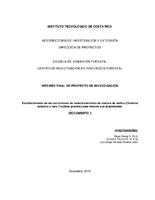Mostrar el registro sencillo del ítem
Establecimiento de las condiciones de termotratamiento de madera de melina (Gmelina arborea) y teca (Tectona grandis) para mejorar sus propiedades (Documento I)
| dc.contributor.author | Moya-Roque, Roger | |
| dc.contributor.author | Tenorio-M., Carolina | |
| dc.contributor.author | Méndez-Álvarez, Luis Diego | |
| dc.date.accessioned | 2019-09-17T20:21:25Z | |
| dc.date.available | 2019-09-17T20:21:25Z | |
| dc.date.issued | 2016 | |
| dc.identifier.uri | https://hdl.handle.net/2238/10796 | |
| dc.description | Informe Final de Proyecto de Investigación. Código del proyecto: 1401062 | es |
| dc.description.abstract | In recent years, new techniques and processes have emerged, such as heat treatment to modify and improve the properties of wood. This study evaluated the effect of thermo-treatment on physical properties (density, shrinking, mass loss, moisture absorption) color measured by the CieLab system, durability by accelerated testing of natural rot resistance, mechanics such as MOR and MOE in flexion, stress adhesion and chemicals by FTIR in wood of Tectona grandis and Gmelina arborea. Sapwood and heartwood samples, sawn under radial and tangential cutting patterns for T. grandis species and wood samples sawn under the radial and tangential cutting patterns for G. arborea were exposed to four temperature levels (205, 210, 215 and 220 ° C) and (185, 190, 195 and 200 ° C) respectively, plus control samples (without thermo-treatment) for each species. Results showed that density varied from 0.61 g cm-3 to 049 g cm-3 and from 0.43 g cm-3 to 0.47 g cm-3 fot T. grandis and G. arborea respectively, with a declining trend as temperature of the thermo-treatment increases in both species. Shrinking percentage fluctuated between 2.61 to 1.20% and from 2.40 to 1.62% for T. grandis and G. arborea respectively, where heartwood timber with tangential cutting pattern thermo-treated at 220°C for T. grandis species and G. arborea timber with tangential cutting pattern thermo-treated at 195 ºC showed the highest shrinking percentages in each species. Mass loss percentage ranged from 11.55 to 14.32 and from 7.75 to 14.09 for T. grandis and G. arborea respectively, reflecting an increase in the mass loss percentage with the increasing of the thermo-treatment temperature. Likewise, the absorption percentage varied from 1.05 to 2.66 % for T. grandis and from 1.39 to 2.37 % for G. arborea showing a decrease for T. grandis and an irregular behavior in G. arborea, when raising the heat treatment temperature Total color change (ΔE*) of wood varied from 21.91 to 40.92 and from 24.95 to 30.24 % for T. grandis and G. arborea respectively, reporting an increase in total color change as the heat treatment temperature increases. The change in color showed the largest changes in the brightness parameter (ΔL*), while redness (Δa*) and yellowing (Δb*) showed minor color changes. MOR varied from 44.18 to 76.63 MPa and from 49.70 to 60.68 Mpa for T. grandis and G. arborea respectively, affected mostly in heartwood timber with radial cut of T. grandis and G. arborea timber with tangential cut thermo-treated at temperatures of 220 and 200ºC respectively. Meanwhile, MOE values ranged from 3.07 to 3.78 GPa and from 6.94 to 8.52 GPa for T. grandis and G. arborea, respectively, reflecting the lowest values in sapwood timber with tangential cut at 205 ºC for T. grandis and in timber without heat treatment with tangential cut for G. arborea. Tension resistance showed a variation between 2.46 and 11.52 % and 4.13 to 8.69 % for T. grandis and G. arborea respectively, with a declining trend as the thermo-treatment temperature increases for both species. Moreover, it was found that failure percentage occurs mostly in wood with values higher than 26%. Durability of wood, showed that L. acuta degraded to a greater degree the wood in relation to T. versicolor. Likewise, it was obtained that G. arborea species is more susceptible to degradation compared to T. grandis. The bands of 1053 and 1108 cm-1 in thermo-treated wood had the highest intensity values regardless of the species, type of wood or cutting type, in relation to the different thermo-treatment temperatures, indicating chemical modification with the heat treatment. Finally, it was found that the heat treatment influences the physical, mechanical and chemical properties of the wood improving in some cases the quality of the same and in others affecting them, however, we must consider the conditions of the process, as well as the temperatures and time of exposure of wood per species and the objective of the same to obtain the best results. | es |
| dc.language.iso | spa | es |
| dc.publisher | Instituto Tecnológico de Costa Rica. Vicerrectoría de Investigación y Extensión (VIE). Escuela de Ingeniería Forestal. Centro de Investigación en Innovación Forestal (CIF) | es |
| dc.rights | acceso abierto | es |
| dc.subject | Durabilidad | es |
| dc.subject | Color | es |
| dc.subject | Wood | es |
| dc.subject | Tratamiento térmico | es |
| dc.subject | Heat treatment | es |
| dc.subject | Densidad | es |
| dc.subject | Density | es |
| dc.subject | Research Subject Categories::NATURAL SCIENCES::Chemistry | es |
| dc.title | Establecimiento de las condiciones de termotratamiento de madera de melina (Gmelina arborea) y teca (Tectona grandis) para mejorar sus propiedades (Documento I) | es |
| dc.type | documento de trabajo | es |


